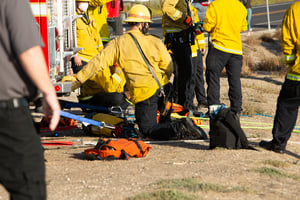What’s Your “Angle”?
There are so many angles to talk about in rope rescue but for now, let’s focus on Low Angle vs. Steep Angle vs. High Angle rescue.
 We hear these terms utilized often in the rescue community, but it is not always clear what each term defines. Each one comes with a degree of slope range, something like;
We hear these terms utilized often in the rescue community, but it is not always clear what each term defines. Each one comes with a degree of slope range, something like;
- 0-15 degree slope is flat terrain
- 15-29 degrees is considered low angle
- 30-50 degrees is steep angle
- anything above 50 degrees is high angle
You may have heard some different numbers associated with each and that’s ok because, in reality, they are just guidelines to help us make informed decisions about what kind of systems to use in a given scenario. If I’m being honest, I don’t really care what the angle is because I still haven’t carried around a protractor in my rescue kit to tell me what degree slope I am working on. I have my own internal protractor, my eyes, my experience, and my level of training. All I am really concerned about is the steeper the ground, the more difficult and the more technical the rescue becomes.
 It is not just the degree of slope that tells me what I need to do, it is also the terrain and the condition of the terrain that makes a BIG difference. The terrain AND the slope are going to be major factors in deciding what rope systems to use as well as how many personnel are involved in the rescue. Some examples of terrain that may push you to utilize ropes in a rescue situation would include loose rock/scree, mud, snow, or any other debris that could cause bad footing and an unstable rescue for the patient. Ropes may have to be used to gain access to the victim, to support the team members and the patients during the rescue and remove them from the rescue site.
It is not just the degree of slope that tells me what I need to do, it is also the terrain and the condition of the terrain that makes a BIG difference. The terrain AND the slope are going to be major factors in deciding what rope systems to use as well as how many personnel are involved in the rescue. Some examples of terrain that may push you to utilize ropes in a rescue situation would include loose rock/scree, mud, snow, or any other debris that could cause bad footing and an unstable rescue for the patient. Ropes may have to be used to gain access to the victim, to support the team members and the patients during the rescue and remove them from the rescue site.
It is not just the degree of slope that tells me what I need to do,
it is also the terrain and the condition of the terrain that makes
a BIG difference.
So, our size-up goes something like this.
- Can rescuers move freely across the terrain without assistance and manage patient movement effectively and safely? Yes = no ropes
- Do rescuers need assistance to safely and/or more efficiently move themselves or the patient, but the ground is predominately supporting the load? Yes = 1 rope system
- Are rescuers and the patient fully supported by the system or a single rope failure would cause catastrophic results? Yes = 2 ropes.
Each one of these scenarios presents its own set of challenges and the systems used can vary greatly. The goal for all of us is to provide for the safety of our teams and the people we are there to help.
Additional Resources




